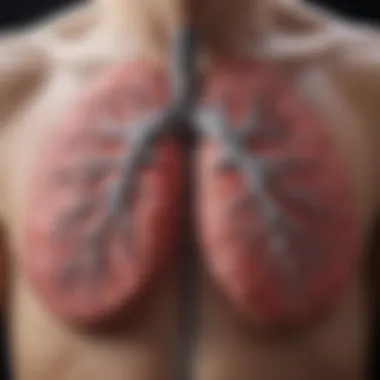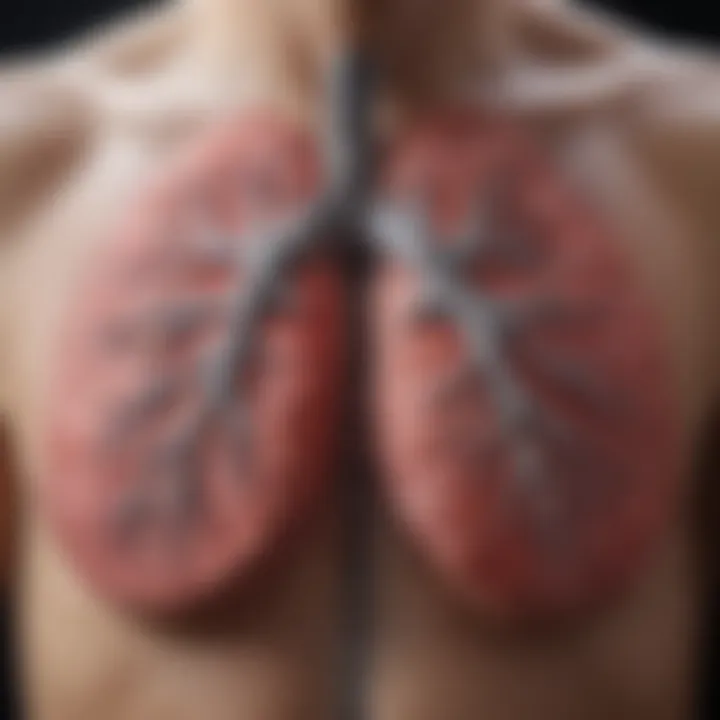Comprehensive Treatment Options for Infected Lungs


Intro
Lung infections represent a significant health challenge globally. They can result from various pathogens, including bacteria, viruses, and fungi. The impact on patients' health can vary widely, from mild respiratory symptoms to severe respiratory failure. Understanding treatment options is essential for effective management, which can directly influence patient outcomes.
Research Overview
Key Findings
Recent studies highlight the complexity of treating lung infections due to varying etiologies. Antimicrobial therapies remain the cornerstone of treatment. However, the emergence of resistant strains has led to the exploration of alternative strategies. This research indicates that personalized medicine, which tailors treatment based on individual responses and pathogen profiles, shows promise in improving efficacy and reducing adverse effects.
Study Methodology
The methodologies employed included systematic reviews of clinical trials, meta-analyses, and observational studies. These approaches allowed researchers to evaluate the efficacy of different treatment modalities. Large-scale studies provided insight into treatment outcomes based on specific pathogens, guiding clinical decisions effectively.
Background and Context
Historical Background
The evolution of treatment options for lung infections has been marked by advances in microbiology and pharmacology. Historically, tuberculosis was a primary concern until the development of antibiotics in the mid-20th century revolutionized therapeutic approaches. However, even with advancements, lung infections remain a leading cause of morbidity and mortality worldwide.
Current Trends in the Field
Today, there is a shift toward understanding the role of the microbiome in lung health. Research into how it interacts with infections is emerging. Furthermore, the use of adjunct therapies in managing severe lung infections is gaining traction. These include specific immunotherapies and advanced supportive care measures like extracorporeal membrane oxygenation (ECMO).
"Understanding the multifaceted nature of lung infections can lead to enhanced treatment strategies, particularly in an era of increasing antibiotic resistance."
Treatment Modalities
Treatment options span several categories, each addressing different aspects of infection management:
- Antimicrobial Therapies: This includes traditional antibiotics, antivirals, and antifungals specifically targeting the identified pathogens.
- Supportive Care: Oxygen therapy, hydration, and nutritional support play critical roles in recovery.
- Emerging Treatments: Innovative therapies such as monoclonal antibodies and gene therapy are in various stages of research and show potential in treating resistant infections.
Ending
The treatment landscape for infected lungs continues to evolve. Continuous research is crucial for developing effective strategies against lung infections. For patients and healthcare providers, staying informed about the latest advances can facilitate better management and improved outcomes.
It is essential to approach treatment with a personalized lens, ensuring that each patient receives the best possible care based on their unique circumstances.
Preface to Lung Infections
Lung infections represent a significant health concern globally. They encompass a range of conditions caused by diverse pathogens, including bacteria, viruses, and fungi. Understanding these infections is crucial for effective diagnosis, treatment, and prevention efforts. This section serves as a foundation for the article, outlining key concepts and the relevance of lung infections in clinical practice.
The importance of this discussion lies in the intricate relationship between lung infections and overall health. Complications can arise not only from the infections themselves but also from delays in diagnosis and treatment. For medical professionals and researchers, it is vital to grasp the multifaceted nature of these infections to enhance patient outcomes and reduce morbidity.
Overview of Lung Infections
Lung infections can manifest as acute or chronic conditions, often characterized by inflammation of lung tissue. The most common forms include pneumonia, bronchitis, and tuberculosis. Symptoms frequently include cough, fever, chest pain, and difficulty breathing. The severity of symptoms typically hinges on the causative agent, the patient's health status, and the timing of intervention.
Various diagnostic tools and clinical evaluation methods assist in identifying the nature and extent of lung infections. By analyzing the type of infection and the patient's overall condition, healthcare professionals can develop tailored treatment plans that address both immediate needs and long-term health.
Epidemiology and Prevalence
The epidemiology of lung infections is diverse, influenced by factors such as geography, socioeconomic status, and underlying health conditions. Global data indicates that millions of cases occur annually, with pneumonia ranking among the leading causes of morbidity and mortality worldwide. Groups particularly at risk include the elderly, young children, and individuals with compromised immune systems.
Factors contributing to the prevalence of these infections include the spread of pathogens, environmental influences, and lifestyle factors such as smoking and air pollution. Public health initiatives aimed at vaccination and early detection are essential in mitigating the impacts of lung infections.
Understanding these epidemiological trends can inform healthcare policies and preventive strategies, ultimately reducing the burden of lung infections and improving public health.
Understanding the Pathophysiology
Understanding the pathophysiology of lung infections is essential for both diagnosing and treating these conditions effectively. Pathophysiology provides insight into the biological mechanisms that underpin lung infections, influencing the choice of treatment options. Grasping these mechanisms assists healthcare professionals in developing individualized treatment plans. Further, it helps illuminate the complexities of host-pathogen interactions, which can impact patient outcomes. A deep comprehension of this topic enables clinicians to anticipate complications, align therapeutic strategies, and enhance overall patient care.
Mechanisms of Infection
Lung infections primarily occur when pathogens invade lung tissue. These pathogens can be viruses, bacteria, or fungi, each employing distinct mechanisms to establish infection. The journey often begins with the inhalation of infectious agents, which may bypass the host's initial defense mechanisms such as nasal hairs, mucus, and the cough reflex.
- Bacterial Infections: Commonly, bacteria like Streptococcus pneumoniae or Staphylococcus aureus adhere to the epithelial cells lining the respiratory tract. They may produce toxins that disrupt host cell function and immune responses, facilitating their spread and colonization.
- Viral Infections: Viruses like influenza and respiratory syncytial virus (RSV) invade epithelial cells directly. They hijack cellular machinery to replicate, often inducing cell death and inflammation, leading to tissue damage.
- Fungal Infections: Fungal pathogens, such as Aspergillus species, can invade lung tissues when the immune system is compromised. They often rely on their ability to evade immune responses, which allows them to proliferate in the lungs.
"Understanding the mechanisms of infection is crucial for devising effective treatment strategies."
This knowledge of infection mechanisms further supports the development of targeted therapies. For example, antibiotic treatments are more effective when tailored to the specific bacteria causing the infection. Similarly, antiviral drugs can be matched to the exact virus involved, improving overall treatment efficacy.
Host Response to Pathogens
The host response to pathogens is a vital aspect of understanding lung infections. Following the initial invasion by pathogens, the body activates its immune system. The innate immune response rapidly responds to the infection, while the adaptive immune response takes longer to develop but offers long-lasting protection.
- Innate Immune Response: This first line of defense includes physical barriers, like the epithelium. Additionally, cells such as macrophages and neutrophils respond quickly to infection, engulfing pathogens and releasing cytokines to signal further immune activity.
- Adaptive Immune Response: This response involves T and B lymphocytes. T cells can kill infected cells while B cells produce antibodies specific to the pathogens. This specificity is crucial for enhancing the immune response against recurrent infections.
Understanding how the host immune system reacts to lung infections allows for more nuanced treatment options. For instance, immunosuppressive therapies may be warranted in cases where the body’s immune response is excessive, leading to tissue damage. Conversely, enhancing the immune response can be beneficial in patients with weakened immune systems.
Common Causes of Lung Infections
Understanding the common causes of lung infections is crucial for effective treatment and prevention strategies. Infected lungs can arise from various pathogens, each with distinct characteristics and implications for clinical management. This knowledge helps healthcare professionals identify the specific type of infection present and tailor treatment accordingly. Moreover, recognizing these causes aids in implementing preventive measures, minimized infection transmission, and improving patient outcomes.


Bacterial Infections
Bacterial infections are one of the leading causes of lung infections. Common pathogens include Streptococcus pneumoniae, Haemophilus influenzae, and Klebsiella pneumoniae. Each of these bacteria can lead to serious conditions like pneumonia, which involves inflammation of the air sacs in one or both lungs. Symptoms may include cough, fever, and difficulty breathing.
To diagnose bacterial infections, healthcare professionals often rely on chest X-rays and sputum cultures. Antibiotic therapy is typically the primary treatment, with specific antibiotics chosen based on the severity of the infection and susceptibility patterns of the bacteria. However, the emergence of antibiotic-resistant strains presents a significant challenge. Practitioners should monitor local resistance patterns and adjust treatment plans as necessary.
Viral Infections
Viral infections are another common source of lung infections, with influenza and respiratory syncytial virus (RSV) being notable examples. These viruses can lead to conditions ranging from mild respiratory illness to severe pneumonia, particularly in vulnerable populations such as infants and the elderly.
Differentiating between viral and bacterial infections can be challenging. Diagnostic tests, like polymerase chain reaction (PCR) assays, provide rapid identification of viral pathogens. Supportive care is often the mainstay of treatment for viral infections, including hydration and rest. Antiviral medications may be used for specific viruses but are not always appropriate. Vaccination remains a key preventive measure against some viral lung infections, emphasizing the importance of public health initiatives.
Fungal Infections
Fungal infections, though less common than bacterial or viral ones, can still pose severe risks, especially in immunocompromised individuals. Fungi such as Aspergillus and Histoplasma can lead to lung diseases, contributing to conditions like chronic pulmonary aspergillosis and histoplasmosis. Exposure to fungal spores is often linked to environmental factors, such as bird droppings or soil contamination.
Diagnosis typically involves imaging studies and serological tests to detect fungal antigens. Treatment may include antifungal medications, and long-term management may be necessary in certain cases. Understanding the types of fungi that affect lungs, alongside the risk factors for infection, is essential for healthcare providers to manage these conditions effectively.
"Identifying the organism causing a lung infection is essential for effective treatment outcomes."
Symptoms and Complications
Understanding the symptoms and complications associated with lung infections is pivotal. Clinical presentation provides insights into the type and severity of the infection, guiding effective treatment choices. Moreover, recognizing potential complications can lead to prompt interventions, potentially averting severe outcomes.
Clinical Presentation
The clinical presentation of lung infections varies based on the underlying cause and the patient's overall health. Common symptoms include:
- Cough: Often, a persistent cough is one of the first signs. It can range from dry to productive, which indicates mucus discharge.
- Difficulty Breathing: Patients may experience shortness of breath, which can escalate if the infection worsens.
- Chest Pain: This can occur, especially when coughing or breathing deeply.
- Fever and Chills: These systemic symptoms are usual, reflecting the body's immune response.
- Fatigue: Patients frequently report a marked decrease in energy levels.
In some cases, specific pathogens present additional symptoms. For instance, viral infections like influenza may cause body aches, while bacterial infections could lead to purulent sputum. Clinicians should carefully assess these symptoms, as they indicate the infection's nature and dynamics.
Potential Complications
Lung infections can lead to various complications that may significantly impact patient health and recovery. Some common complications include:
- Pleural Effusion: This is the accumulation of fluid in the pleural cavity, leading to further respiratory distress.
- Pneumothorax: A complicated form of lung infection where the lung collapses, potentially requiring immediate medical attention.
- Sepsis: Severe infections can spread to the bloodstream, causing sepsis, a life-threatening condition.
- Lung Abscesses: These localized collections of pus in the lungs can be a direct result of bacterial infections and require surgical intervention.
- Respiratory Failure: In extreme cases, the lungs may not deliver adequate oxygen. This condition demands urgent medical support.
"Complications from lung infections can escalate quickly, necessitating vigilant monitoring and timely intervention."
Effective management of these symptoms and complications is crucial for quality patient care. Continuous assessment and a clear understanding of clinical manifestations can guide clinicians toward appropriate treatment pathways, improving patient outcomes.
Diagnostic Approaches
Accurate diagnosis of lung infections is paramount in determining effective treatment options and improving patient outcomes. A systematic approach encompasses clinical evaluation, laboratory tests, and imaging techniques. Each of these elements plays a critical role in not only confirming the presence of an infection but also in identifying the specific pathogens involved. Understanding these diagnostic approaches allows healthcare professionals to tailor their treatment strategies to individual patient needs, thus enhancing the efficacy of the interventions employed.
Clinical Evaluation
The first step in diagnosing lung infections is a thorough clinical evaluation. This process involves gathering an exhaustive medical history from the patient, which includes symptoms, duration of illness, and any prior health issues that could complicate the diagnosis. Physical examination is equally important; healthcare providers will auscultate the chest, observing for any abnormal breath sounds such as wheezing, crackles, or decreased breath sounds, which may suggest infection.
Furthermore, detailed questioning regarding risk factors is essential. For instance, recent travel, exposure to known pathogens, home location, and vaccination history provide crucial context that aids diagnosis. The use of validated scoring systems, such as the CURB-65 score for community-acquired pneumonia, can also assist in stratifying the severity of illness, guiding further management decisions.
Laboratory Tests
Laboratory tests complement the clinical evaluation by providing objective data to support the diagnosis. **Commonly used tests include:
- Complete Blood Count (CBC): This test can indicate the presence of infection through elevated white blood cell counts.
- Sputum Culture: Collecting a sputum sample helps identify the specific bacteria, viruses, or fungi involved in the infection. Prompt initiation of targeted antimicrobial therapy is often reliant on these results.
- Blood Cultures: Particularly important for suspected cases of pneumonia, blood cultures help detect any bacteremia, guiding treatment choices.
- Pulse Oximetry: Non-invasive monitoring of oxygen saturation is critical to assess the severity of respiratory compromise and the need for supplemental oxygen.
These tests not only assist in confirming the diagnosis but also provide insight into the appropriate treatment options available to manage the infection effectively.
Imaging Techniques
Imaging plays a vital role in the diagnostic process for lung infections. Commonly used techniques include chest X-rays and CT scans. Chest X-rays are often the first imaging study performed since they can quickly reveal abnormalities such as consolidation, which indicates pneumonia, or pleural effusions. In more complicated cases or when initial findings are inconclusive, computed tomography (CT) scans may be conducted to provide a more detailed view of lung structures.
"Imaging is a key element in managing lung infections. It helps distinguish between typical bacterial infections and those that may have complications or involve less common pathogens."
Additionally, ultrasound can be used to evaluate pleural effusions, guiding potential drainage procedures. This multimodal imaging approach ensures healthcare providers have the most comprehensive view of lung conditions at their disposal.
In summary, the diagnostic approaches for lung infections are multifaceted and interdependent. Each component, from clinical evaluation to advanced imaging techniques, contributes to a clearer picture of the patient’s condition. By leveraging these diagnostics, clinicians can formulate more effective, evidence-based treatment plans tailored to the specific needs of their patients.
Antimicrobial Treatment Options
Antimicrobial treatment options are crucial in addressing lung infections, as these interventions directly target the pathogens responsible for the illness. These treatments encompass a variety of medications tailored to combat bacterial, viral, and fungal infections. The effectiveness of antimicrobials can significantly influence patient outcomes, recovery times, and the overall management of lung infections. An appropriate choice of antimicrobials is essential, considering factors such as the specific pathogen involved, the patient's health status, and potential resistance patterns. Therefore, understanding these treatment options is vital for healthcare professionals and patients alike.
Antibiotic Therapy
Antibiotic therapy remains the cornerstone of treating bacterial lung infections. The selection of antibiotics must be guided by factors such as the type of bacteria involved, local resistance patterns, and individual patient circumstances. Common antibiotics prescribed include amoxicillin, azithromycin, and ciprofloxacin. Each antibiotic has its spectrum of activity against different bacteria.
- Amoxicillin is often used for uncomplicated cases, especially those caused by Streptococcus pneumoniae.
- Azithromycin can be particularly beneficial in treating atypical pneumonias caused by organisms like Mycoplasma pneumoniae.
- Ciprofloxacin is reserved for more severe infections or cases resistant to front-line treatments.
It's important to use antibiotic therapy judiciously to minimize the risk of developing antibiotic resistance. Long-term use of antibiotics when they are not necessary can contribute to resistance, making infections harder to treat later.
Antiviral Agents


Antiviral agents play a key role in managing viral lung infections, particularly influenza and respiratory syncytial virus (RSV). For instance, oseltamivir is commonly prescribed for influenza, which can help reduce the severity and duration of the virus if taken early. Similarly, ribavirin may be useful for specific cases of RSV, particularly in high-risk populations, such as infants.
A significant consideration in antiviral treatment is the timing of the administration. The effectiveness of antiviral agents is highest when administered soon after the onset of symptoms. While antiviral medications can improve outcomes, not all viral infections have effective antiviral options, highlighting the need for ongoing research in this field.
Antifungal Treatment
Antifungal treatment is necessary when lung infections are caused by fungal organisms. Fungal lung infections, although less common than bacterial or viral infections, can be serious. Common agents include fluconazole and voriconazole.
- Fluconazole is effective against Candida species and certain types of histoplasmosis.
- Voriconazole is often used for treating Aspergillus infections.
The choice of antifungal treatment must consider the specific type of fungus identified. It is also essential to monitor the patient's response and adjust treatment as necessary. Fungal infections can often mimic bacterial pneumonia, leading to potential misdiagnosis. Thus, it is critical to obtain accurate laboratory diagnoses to guide appropriate treatment strategies.
The choice of antimicrobial therapy is vital for the effective management of lung infections. Close collaboration with microbiologists and infectious disease specialists can enhance treatment outcomes and minimize risks associated with resistant pathogens.
In summary, antimicrobial treatment options are diverse and tailored to the types of pathogens involved in lung infections. Understanding the nuances of antibiotics, antivirals, and antifungals allows for better management, ultimately improving patient care.
Supportive Care Strategies
Supportive care strategies play a critical role in managing lung infections. They aim to alleviate symptoms, enhance recovery, and improve the overall quality of life. These interventions are especially important as they complement medical treatment, ensuring that a patient's condition does not deteriorate while awaiting the effects of specific therapies. The essence of supportive care lies in its capacity to provide symptomatic relief and address the physiological needs of the patient.
There are several key elements to supportive care strategies that warrant attention:
- Symptom Management: Effective supportive care can significantly improve symptoms of lung infections, such as shortness of breath, cough, and fatigue. It's essential to tailor these strategies to each patient's needs.
- Enhanced Treatment Efficacy: By supporting the body’s physiological processes, such care can optimize the effectiveness of antimicrobial therapies and other treatments.
- Overall Well-being: Patients with lung infections often experience anxiety and distress. Supportive care can offer psychological support, contributing to better mental health outcomes.
Oxygen Therapy
Oxygen therapy is a fundamental aspect of supportive care for patients with lung infections, particularly in cases where gas exchange is impaired. The primary goal of oxygen therapy is to ensure sufficient oxygen saturation in the blood, improving the delivery of oxygen to vital organs.
This therapy can be administered in various ways, including:
- Nasal Cannula: This method delivers oxygen through thin tubes placed in the nostrils. It is less obtrusive and allows patients to speak and eat without difficulty.
- Oxygen Masks: These are used when higher concentrations of oxygen are required. Masks can cover the nose and mouth, providing a better seal for effective oxygen intake.
- Mechanical Ventilation: In more severe cases, invasive methods may be necessary to support patients who cannot breathe independently or adequately.
The appropriate choice of method depends on the patient's specific condition. Monitoring is crucial, as too much oxygen can lead to toxicity, which is why healthcare providers must carefully adjust the therapy.
Fluid and Electrolyte Management
Fluid and electrolyte management also represents a vital supportive care strategy in treating lung infections. Patients can experience dehydration due to fever, increased respiratory rate, or reduced fluid intake. Maintaining adequate hydration is essential for various physiological functions, including:
- Mucociliary Clearance: Proper hydration helps keep airway secretions thin, facilitating clearer airways and thereby aiding in better lung function.
- Circulation: Fluids maintain blood volume, supporting adequate perfusion to tissues which is essential during inflammatory responses.
Fluids can be administered orally or intravenously, depending on the severity of dehydration. Electrolyte imbalances can lead to complications, so close monitoring is necessary. For example, an imbalance between sodium and potassium can impact cardiac function, making it imperative to restore equilibrium promptly.
"Effective supportive care, including oxygen and fluid management, is essential for optimal recovery from lung infections."
Emerging Treatment Modalities
Emerging treatment modalities for lung infections provide new hope and potential solutions amidst growing concerns of antimicrobial resistance and the need for more effective therapies. These approaches aim to enhance patient outcomes by targeting specific pathogens or modifying the host's immune response. The exploration of monoclonal antibodies and vaccine developments reflects a shift towards personalized and preventive medicine.
The significance of these modalities lies not only in their innovative nature but also in their ability to address unmet needs within the field. As traditional treatment methods are often accompanied by limitations, emerging strategies offer alternatives that can potentially improve compliance, reduce side effects, and increase efficacy.
Monoclonal Antibodies
Monoclonal antibodies have emerged as a promising area in the treatment of lung infections. They are lab-produced molecules that can bind to specific targets, such as viruses or bacteria, enhancing the body’s immune response. One of the key benefits of using monoclonal antibodies is their targeted approach. Unlike broad-spectrum antibiotics, which can affect a wide range of bacterial species, monoclonal antibodies are designed to attack specific pathogens, reducing the risk of harming beneficial microbes in the body.
For instance, monoclonal antibodies such as palivizumab are utilized in the prevention of respiratory syncytial virus (RSV) in high-risk pediatric populations. This not only decreases the incidence of severe infections but can also alleviate the overall healthcare burden associated with RSV. Additionally, as clinical research progresses, we see the development of monoclonal antibodies aimed at other pathogens that cause lung infections, including bacterial strains resistant to conventional treatments.
However, there are considerations to keep in mind. While monoclonal antibodies can be effective, they are often expensive and may not be accessible in all healthcare settings. The administration of these therapies also requires careful consideration of timing and patient-specific factors to enhance effectiveness.
Vaccine Developments
The advancement of vaccines represents another critical aspect of emerging treatment modalities for lung infections. Vaccination programs are key to preventing infections, thereby decreasing the incidence and spread of infectious diseases affecting the lungs. Vaccines work by preparing the immune system to respond quickly to infections, leading to immunological memory that can prevent future illness.
Recent developments focus on vaccines for various pathogens including influenza, pneumococcus, and even some viral infections like COVID-19. The urgency brought on by the COVID-19 pandemic has accelerated research and development timelines, leading to new insights and technologies in vaccine formulation.
"Vaccines not only save individual lives but also protect communities by enhancing herd immunity."
Moreover, the emphasis is shifting towards vaccines that offer broad protection against multiple strains of pathogens. This is particularly potent in the case of influenza where viruses evolve rapidly, making it essential to update vaccines regularly. The continuous innovation in this area is vital to keep pace with emerging infectious diseases and changing epidemiology.
While vaccines are indispensable, barriers such as vaccine hesitancy and access can hinder their impact. Addressing these challenges is critical for maximizing their effectiveness in public health.
Together, monoclonal antibodies and vaccine developments signify a transformative phase in managing lung infections. As data from clinical trials and real-world applications gather, these modalities are only expected to grow in their importance, shaping the future landscape of lung infection management.
Preventive Measures and Public Health
Preventive measures play a pivotal role in the management of lung infections. A proactive approach not only minimizes the risk of infection but also contributes to public health safety. This section outlines the importance of vaccination programs and infection control practices. Both strategies are essential for reducing the incidence of lung infections at a population level.
Vaccination Programs
Vaccination is one of the most effective preventive measures against lung infections. Vaccines work by stimulating the immune system to recognize and combat pathogens. For instance, the influenza vaccine significantly reduces the risk of viral pneumonia, while the pneumococcal vaccine targets bacterial infections such as pneumonia and meningitis.
The implementation of vaccination programs helps establish herd immunity. When a sufficient segment of the population is vaccinated, there is a lower chance for the virus and bacteria to spread, offering protection even to those who are unvaccinated. Key considerations for effective vaccination programs include:
- Accessibility: Ensure vaccines are available to all populations, especially vulnerable groups like the elderly or immunocompromised individuals.
- Education: Raise awareness about the importance of vaccines and dispel misinformation surrounding them.
- Monitoring: Track vaccination rates and effectiveness to adapt strategies as needed, ensuring the population continues to benefit from immunity.


"Vaccines not only protect the individual but also contribute to community health by reducing overall transmission of infectious diseases."
Infection Control Practices
Infection control practices are essential in preventing the spread of lung infections, particularly in healthcare settings. Effective infection control measures include the following:
- Hand Hygiene: Regular hand washing with soap or the use of alcohol-based hand sanitizers is critical. This simple practice can significantly reduce transmission rates.
- Respiratory Etiquette: Encouraging individuals to cover their mouths when coughing or sneezing can limit airborne pathogens. Additionally, wearing masks in crowded places can be an effective barrier to infection.
- Environmental Cleaning: Regular disinfection of surfaces and equipment helps reduce the load of pathogens in public and healthcare environments. High-touch surfaces should receive special attention.
- Isolation Procedures: In healthcare facilities, isolating patients with known infections prevents the spread to others, protecting both staff and patients.
Implementing these infection control practices is paramount. They not only aim to protect individual patients but also focus on the health of communities by minimizing outbreaks and reducing the strain on healthcare systems. This comprehensive strategy enhances public health and promotes a safer environment for all.
Patient Education and Compliance
Patient education and compliance are critical components in the management of lung infections. Understanding lung infections, their treatments, and the importance of adherence to therapy can significantly influence patient outcomes. Effective communication and education can bridge the gap between healthcare professionals and patients, ensuring that the therapeutic process is more than just prescribed medications.
Education empowers patients by providing them with necessary information about their condition. Knowledge about the nature of lung infections—including the causes, symptoms, and potential complications—enables patients to make informed decisions regarding their health. For instance, knowing the risks associated with untreated infections can motivate individuals to adhere to their prescribed treatment plans. This understanding fosters a sense of responsibility and encourages proactive involvement in their care.
Additionally, patient education addresses several specific elements that enhance compliance:
- Understanding Medication: Explaining the purpose and dosage of prescribed medications helps patients appreciate their role in recovery.
- Recognizing Symptoms: Educating patients about signs of improvement or worsening symptoms allows timely intervention, which is vital in managing lung infections.
- Managing Side Effects: Informing patients about potential side effects reduces anxiety, leading to better adherence to therapies despite possible discomforts.
The benefits of strong patient education and compliance cannot be overstated. Evidence suggests that patients who are well-informed about their treatment are more likely to follow through with their medications, which can result in faster recovery times and reduced rates of complications. Moreover, engaging patients in discussions about their treatment enhances their confidence and can lead to overall improved health outcomes.
“Patient compliance is not just about following instructions; it is about understanding the journey towards recovery.”
Furthermore, considering patient-specific factors, such as literacy levels, cultural background, and personal beliefs, is crucial in tailoring educational approaches. For instance, using visual aids or simple language can be beneficial, particularly for those with lower health literacy. It is also important for care providers to encourage questions, allowing patients to express concerns and reinforce their understanding.
Overall, effective patient education acts as a foundation for compliance, facilitating not only better health outcomes but also fostering a collaborative relationship between patients and healthcare professionals.
Research Trends and Future Directions
Research in the field of lung infections is pivotal for advancing treatment options and improving overall patient care. As the landscape of infectious diseases continues to evolve, it is paramount for researchers and clinicians to stay abreast of emerging trends. This section evaluates the significance of current research initiatives and innovative technologies. Both elements form the backbone of future treatment strategies, and understanding them is crucial for healthcare professionals and educators alike.
Current Research Initiatives
Numerous research initiatives are ongoing in the realm of lung infections. These projects aim to explore not just the pathogens themselves but also the host responses and how these interactions affect treatment outcomes. Some noteworthy initiatives include:
- Understanding Pathogen Variability: Research is focused on characterizing different strains of bacteria and viruses that cause lung infections. This variability can influence treatment strategies, as some strains may be more resistant to standard therapies.
- Antimicrobial Stewardship Programs: There are efforts to assess the efficacy of these programs in reducing antibiotic misuse, which is a growing concern in the treatment of lung infections.
- Immunotherapy Research: Investigating how the immune system can be harnessed to fight off lung infections is gaining traction. This includes studying the use of monoclonal antibodies and other immune-modulating therapies.
These initiatives not only enhance our understanding of lung infections but also open doors to new treatment paradigms, ensuring a more personalized approach in therpay.
Innovative Technologies in Treatment
Innovations in technology have the potential to revolutionize the way lung infections are diagnosed and treated. Some of the key areas of focus include:
- Next-Generation Sequencing (NGS): This technology allows for rapid sequencing of microbial genomes, speeding up the identification of pathogens in infected lungs. NGS can enhance the accuracy of diagnoses and inform more targeted treatment protocols.
- Digital Health Tools: Telemedicine has emerged as an essential tool for managing lung infections. Remote monitoring systems allow healthcare providers to keep track of patient recovery and make timely interventions.
- Artificial Intelligence (AI): The use of AI in imaging analysis is increasingly prevalent. AI can help in detecting early signs of lung infections via radiological images, potentially improving outcomes by facilitating prompt treatment.
The application of innovative technologies not only optimizes the treatment process but also promotes efficiency in healthcare delivery.
Understanding these research trends and technologies is vital for all stakeholders in lung infection treatment. As the field evolves, a proactive approach to integrating these advancements into clinical practice will prove beneficial in managing this significant public health challenge.
Case Studies and Clinical Outcomes
Analyzing clinical outcomes from these case studies allows for a better grasp of the varied responses to treatments among different individuals. Lung infections can arise from multiple pathogens, such as bacteria, viruses, or fungi, and each may react distinctively to treatment protocols. This complexity necessitates a nuanced understanding of case examples, guiding clinicians in selecting the most appropriate therapeutic strategies for their patients.
In addition, case studies emphasize the importance of personalized medicine. Individual patient factors, including age, comorbidities, and genetic predispositions, can heavily influence treatment efficacy. Observing diverse case studies helps in formulating tailored treatment plans that address these unique characteristics.
"The analysis of successful treatments enhances our understanding of what works in practice, leading to better patient outcomes."
Analysis of Successful Treatments
Successful treatments for lung infections can frequently be traced back to well-documented case studies. For instance, specific antibiotic regimens have shown remarkable results in treating pneumonia caused by Streptococcus pneumoniae.
- Case Example 1: A 65-year-old male presented with severe pneumonia. After careful evaluation, the medical team administered a course of amoxicillin-clavulanate. This choice resulted in significant improvement within days, demonstrating the importance of selecting the right antibiotic based on infection type.
- Case Example 2: A young woman diagnosed with viral pneumonia benefited from a combination of antiviral medications and supportive care strategies. Her recovery highlighted the necessity of utilizing a multifaceted treatment plan that expanded beyond just medication.
In both examples, the documentation and outcome assessments provided valuable insights not only for the treating teams but also for other practitioners. Successful treatments often become benchmarks for future cases, improving overall understanding and management of lung infections.
Challenges in Management
While successful case studies provide valuable information, not all patients respond positively to treatments. Several challenges can arise in managing lung infections.
- Variability in Patient Response: Each patient may respond differently to the same treatment. Factors such as the severity of the infection, host immunity, and pre-existing health conditions can lead to variations in outcomes.
- Antibiotic Resistance: The rise of antibiotic-resistant strains poses significant challenges in treatment options. For example, organisms like Methicillin-resistant Staphylococcus aureus (MRSA) complicate standard treatment protocols and necessitate more aggressive strategies.
- Late Diagnosis: A delay in accurate diagnosis can lead to advanced infection stages where treatment options are more limited. Early recognition is crucial but can be challenging due to overlapping symptoms with other conditions.
- Resource Availability: Access to advanced diagnostic tools and treatments can vary greatly by location. In underserved areas, lack of resources may hinder proper management of lung infections.
By understanding these challenges, healthcare professionals can better prepare for and address the complexities involved in treating lung infections. Each obstacle emphasizes the need for continued research, education, and the development of strategies tailored to diverse patient populations.
Closure
One key benefit of clearly articulating a conclusion is its ability to reinforce the main points discussed. In the context of lung infections, the potential for serious complications makes it essential for healthcare professionals to have a coherent understanding of the treatment landscape. A concise summary allows readers to grasp essential points quickly, fostering familiarity with the topic that is beneficial for future practice and decision-making.
Furthermore, the conclusion underscores the dynamic nature of medical research in this area, indicating that treatment options are not static but continuously evolving. This aspect invites ongoing attention and encourages healthcare providers to stay informed about the latest advancements in treatment options.
"The management of lung infections relies not solely on established practices but also on the integration of new scientific findings into clinical routines."
Summary of Key Takeaways
- Comprehensive Overview: The article provides an extensive summary of treatment options for lung infections, covering various therapies and care strategies.
- Antimicrobial Focus: A significant emphasis is placed on antimicrobial treatment options, detailing antibiotics, antivirals, and antifungals.
- Supportive Care: Support methods like oxygen therapy and fluid management are crucial and should not be overlooked.
- Emerging Therapies: Continuous research reveals innovative treatment opportunities, including monoclonal antibodies and vaccines.
- Importance of Education: Patient compliance and understanding treatment are paramount for success.
Future Outlook in Treatment Options
- Advancements in Genomics: The evolution of genomic sequencing may introduce personalized therapies tailored to the genetic makeup of pathogens and patients.
- Innovative Drug Development: There is potential for new classes of antimicrobial drugs targeting resistant pathogens, which are increasingly becoming a public health concern.
- Enhanced Diagnostic Tools: Improved diagnostic techniques could facilitate quicker and more accurate identification of infections, allowing for timely and effective treatment interventions.
- Vaccine Research: Ongoing vaccine developments may reduce the incidence of certain lung infections, preventing complications before they arise.
In summary, the trajectory of treatment options is towards innovations that enhance efficacy and patient outcomes. Healthcare professionals must stay adaptable and informed to leverage these advancements effectively. This commitment to continuous improvement in treatment strategies not only benefits patient care but also contributes to the larger public health discourse surrounding lung infections.







